-

人教版新目标初中英语九年级下册Rainy days make me sad教案
1. 教材分析本单元以how do things affect you?为话题, 从颜色、天气、音乐、广告、产品等方面谈论了外界事物如何影响人的心情。要求学生掌握表达某物或某事给人带来的感觉、看法或影响等。共设计了四个部分的内容:Section A 该部分有4个模块:第一模块围绕Which restaurant would you like to go to?这一话题展开思维(1a)、听力(1b)、口语(1c)训练;第二模块围绕How does music affect you? 进行听力(2a-2b)、口语训练(2c);第三模块继续围绕how do colors in the restaurant affect you这一话题展开训练,训练形式为阅读和问题体验(3a)和小组活动(3b);第四模块仍就How do things affect you这一话题以调查的形式展开讨论。Section B该部分有4个模块:第一模块围绕产品广告对人们的影响这一话题以“配对”(1a)与“列举”(1b)两种形式展开训练;第二模块继续围绕How do things affect you? 进行听力(2a-2b)、口语对话训练(2c);第三模块围绕“Advertising”这一话题展开阅读(3a-3b)和写作(3c)训练;第四模块围绕How posters affect you这一话题以口语训练形式展开小组活动。

人教版新目标初中英语九年级下册Could you please tell me where the restrooms are教案
Step Ⅰ RevisionCheck homework. Ask a few students to read the article in 3a.Then ask a few students to read their guides.Step Ⅱ Part 1Look at the words in the box. Ask a student to read them. Make sure the students understand the meaning of the words. You are to fill in the blanks with the words. In some cases, students may need to use another form of the word, for example adjusting for tense or subject/ verb agreement.Ask students to fill in the blanks on their own.Check the answers. Step ⅢPart 2Go through the instructions with the class.Look at the example with the students.Ask students what the answer would be.Ask a student to read the question and answer it.Excuse me, could you tell me where the bank is, please?The bank is across the street from the shopping malt.Get students to complete the work in pairs.Check the answers. Ask a few students to read their questions.Step Ⅳ Just for Fun!Ask all the students to read the conversation. Ask: What is funny about this cartoon? Help students to explain. A Martian is a person from the planet Mars.There is no such thing as Martian food on Earth, and the clerk looks silly because he is trying to think of where there is a Martian restaurant.Invite some pairs of students to present this conversation to the rest of the class.Step Ⅴ Summary and HomeworkIn this class, we’ve done much writing practice using the key vocabulary words and the target language presented in this unit. After class, please finish the questions in 2 in your exercise books. Then finish the exercises on pages 47~48 of the workbook as well.The Seventh Period Ⅰ Teaching Aims and Demands1. Knowledge Objects(1) Key Vocabularyimage, adventure, jealousy, hero, crime, journey, brave, no longer, show interest in, take it easy, become interested in, plain looks(2)Text:Grown-ups like cartoons, too.2. Ability Objects(1) Fast-reading to get a general idea of the text.(2) Careful-reading to get the detailed information in the text.

人教版新目标初中英语九年级下册I’ll help clean up the city parks教案
Talk about offering help (P60)I’ll help clean up the city parks.A: I’d like to work ...B: You could help ...Talk about ways to tell people about the Clean-Up Day (P61)We need to ...We can’t ...I’ll ...Talk about the work the volunteers do (P62)These three students all volunteer their time to help other people.Somebody loves to ... / helps ... / plans to ... / wants to ...A: What do you like doing?B: I like ... A: What kind of volunteer work do you think I could do?B: You could ...1. 重点词汇advertisement, fix, repair, pleasure, blind, deaf, shut, carry, specially, fetch2. 认读词汇hunger, homeless, cheer, clean-up, sign, establish, major, commitment, elementary, veterinarian, coach, similar, call-in, strategy, disabled, organization, unable, support, appreciate, donation, part of speech, pronoun, adverb, preposition, conjunction, donate, Jimmy, Sally3. 词组clean up, cheer up, give out, put off, set up, think up, take after, fix up, give away, put up, hand out, work out, at once

人教版新目标初中英语九年级下册We’re trying to save the manatees教案2篇
本单元主要围绕着有关濒临灭绝的动物这一话题,学习了应该怎样保护我们的环境,以及就某一问题展开辩论。目标提示语言目标能够运用所学知识,就某一问题展开辩论。认知目标1、复习一些语法:现在进行时、一般现在时、用used to 表示一般过去时、现在完成时、一般过去时的被动语态。2、学会表达同意和不同意。3、学会以下基本句型:We’re trying to save the manatees.Manatees eat about 100 pounds of food a day.There used to be a lot of manatees.In 1972,it was discovered that they were endangered.Some of the swamps have become polluted.情感目标了解一些濒临灭绝的动物的生活习性和濒临灭绝的原因,教育学生应该如何保护环境。教学提示充分利用多媒体等教学设备,创设与本课话题相关的情境,如各种不同种类的动物、动物园以及有关环境的画画等等。围绕着本单元的教学目标,设计一些贴近学生实际的教学任务,如让学生谈论自己最喜欢的动物,如何拯救濒危动物,如何保护环境等等。让学生根据所学知识,就动物园是否对动物有利以及其他的话题进行辩论。
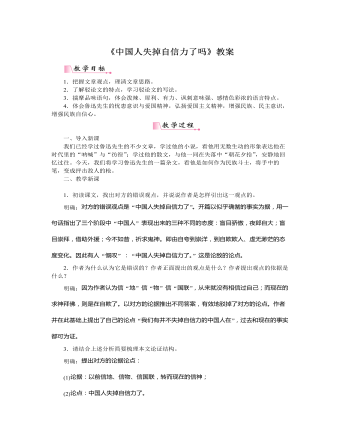
部编版语文九年级上册《中国人失掉自信力了吗》教案
一、导入新课我们已经学过鲁迅先生的不少文章,学过他的小说,看他用无数生动的形象表达他在时代里的“呐喊”与“彷徨”;学过他的散文,与他一同在失落中“朝花夕拾”,安静地回忆过往。今天,我们将学习鲁迅先生的一篇杂文,看他是如何作为民族斗士,将手中的笔,变成抨击敌人的枪。二、教学新课目标导学一:学习驳论,理清思路1.初读课文,找出对方的错误观点,并说说作者是怎样引出这一观点的。明确:对方的错误观点是“中国人失掉自信力了”。开篇以似乎确凿的事实为据,用一句话指出了三个阶段中“中国人”表现出来的三种不同的态度:盲目骄傲,夜郎自大;盲目崇拜,借助外援;今不如昔,祈求鬼神。即由自夸到崇洋,到自欺欺人、虚无渺茫的态度变化。因此有人“慨叹”:“中国人失掉自信力了。”这是论敌的论点。
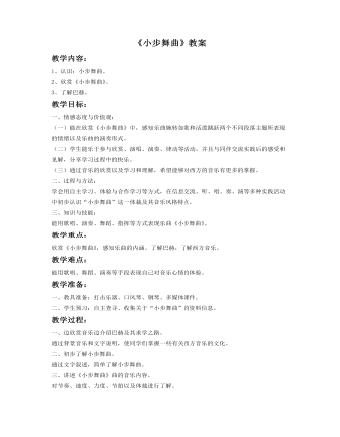
《小步舞曲教案》教案
教学过程:一、边欣赏音乐边介绍巴赫及其求学之路。通过背景音乐和文字说明,使同学们掌握一些有关西方音乐的文化。二、初步了解小步舞曲。通过文字叙述,简单了解小步舞曲。三、讲述《小步舞曲》曲的音乐内容。对节奏、速度、力度、节拍以及体裁进行了解。四、结合谱例分段学习《小步舞曲》。1、学习乐曲A’段。说明:依据乐曲创作背景,合理创设“舞会”情景,从而有效激发学生学习兴趣,用舞蹈表现手段演绎此乐段,发展了学生的舞蹈表演能力,享受到美的愉悦。2、学习乐曲B段。说明:利用形象、直观的图式辅助以及一系列贴近学生思维逻辑的问答讨论,激发学生的思考,帮助学生准确把握乐段情绪,并能用指挥、伴奏等方式表现该乐段。3、完整欣赏《小步舞曲》。说明:学生在完整欣赏乐曲时能够巩固乐曲主题的记忆,并且听辨、感受乐曲两个不同主题情绪,培养学生独立的音乐感受和见解。五、视频欣赏。说明:通过视屏欣赏,使同学们以一个更直观的郊区去理解和学习作品,并使同学对作品有更深刻的记忆。引起学生共鸣,领悟音乐的美感,愉悦身心,获取乐趣,从而激起学习的情趣。

人教版新课标高中地理必修2第六章第一节人地关系思想的演变教案
环境问题 是伴着人口问题、资源问题和发展问题产生。本质是发展问题 ,可持续发展。6分析可持续发展的概念、内涵和 原则?可持续发展的含义:可持续发展是这样的发展,它既满足当代人的需求,而又不损害后代人满足其需求的能力。可持续发展的内涵:生态持续发展 ,发展的基础;经济持续发展,发展条件;社会持续发展,发展目的。可持续发展的原则:公平性原则——代内、代际、人与物、国家与地区之间;持续性原则——经济活动保持在资源环境承载力之内;共同性原则— —地球是一个整体。【总结新课】可持续发 展的含义:可持续发展是这样的发展,它既满足当代人的需求,而又不损害后代人满足其需求的能力。可持续发展的内涵:生态持续发展,发展的基础;经济持续发展,发展条件;社会持续发展,发展目的。
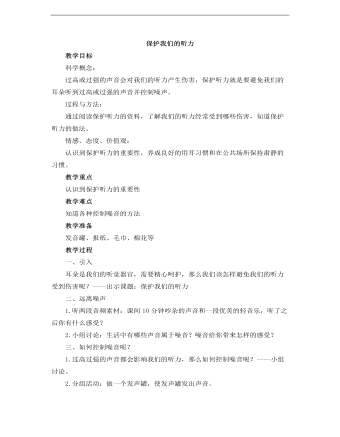
小学科学教科版四年级上册《保护我们的听力》教案
过程与方法:通过阅读保护听力的资料,了解我们的听力经常受到哪些伤害,知道保护听力的做法。情感、态度、价值观:认识到保护听力的重要性,养成良好的用耳习惯和在公共场所保持肃静的习惯。教学重点认识到保护听力的重要性教学难点知道各种控制噪音的方法教学准备发音罐、报纸、毛巾、棉花等
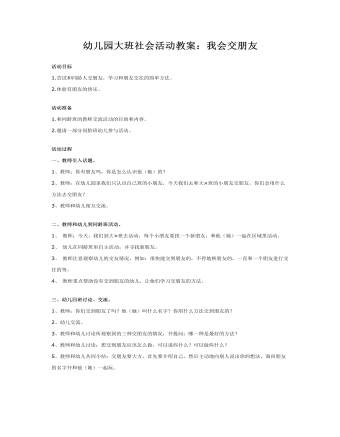
幼儿园大班社会活动教案:我会交朋友
活动准备 1.和同龄班的教师交流活动的目的和内容。 2.邀请一部分同龄班幼儿参与活动。活动过程 一、教师引入话题。 1、教师:你有朋友吗,你是怎么认识他(她)的? 2、教师:在幼儿园里我们只认识自己班的小朋友,今天我们去和大×班的小朋友交朋友,你们会用什么方法去交朋友? 3、教师和幼儿相互交流。
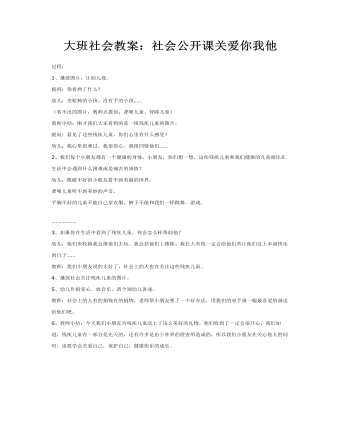
大班社会教案:社会公开课关爱你我他
2、我们每个小朋友都有一个健康的身体,小朋友,你们想一想,这些残疾儿童和我们健康的儿童相比在生活中会遇到什么困难或是痛苦的事情?幼儿:眼睛不好的小朋友看不到美丽的世界。聋哑儿童听不到美妙的声音。手脚不好的儿童不能自己穿衣服,裤子不能和我们一样跳舞,游戏。………………3、如果你在生活中看到了残疾儿童,你会怎么样帮助他?幼儿:他们坐轮椅我会推他们去玩、我会扶他们上楼梯、我长大有钱一定会给他们些让他们过上幸福快乐的日子……教师:我们小朋友说的太好了,社会上的人也在关注这些残疾儿童。
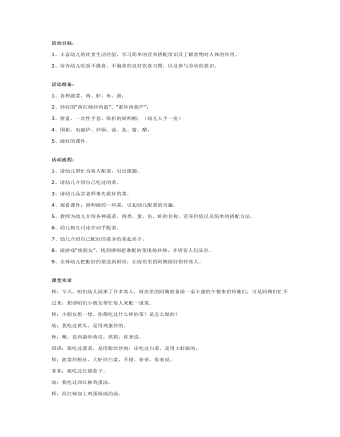
幼儿园大班健康教案:我是厨房小帮手
活动准备: 1、各种蔬菜、肉、虾、鱼、蛋; 2、炒好的“西红柿炒鸡蛋”、“素炒西葫芦”; 3、拼盘、一次性手套、纸折的厨师帽;(幼儿人手一份) 4、围裙、电磁炉、炒锅、油、盐、酱、醋。 5、做好的课件。 活动流程: 1、请幼儿帮忙为客人配菜,引出课题。 2、请幼儿介绍自己吃过的菜。 3、请幼儿品尝老师事先做好的菜。 4、观看课件:厨师做的一些菜,引起幼儿配菜的兴趣。 5、教师为幼儿介绍各种蔬菜、肉类、蛋、鱼、虾的名称、营养价值以及简单的搭配方法。 6、幼儿相互讨论并动手配菜。 7、幼儿介绍自己配好的菜并给菜起名字。 8、做游戏“找朋友”,找到谁则把谁配的菜现场炒熟,并请客人们品尝。 9、全体幼儿把配好的菜送到厨房,让厨房里的阿姨做好招待客人。
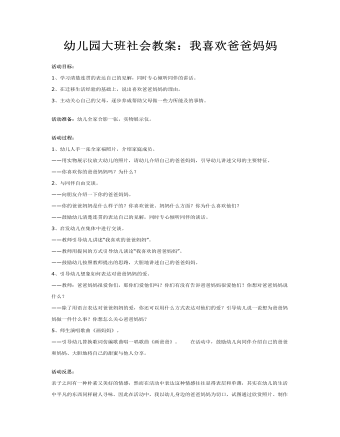
幼儿园大班社会教案:我喜欢爸爸妈妈
活动准备:幼儿全家合影一张,实物展示仪。活动过程:1、幼儿人手一张全家福照片,介绍家庭成员。——用实物展示仪放大幼儿的照片,请幼儿介绍自己的爸爸妈妈,引导幼儿讲述父母的主要特征。——你喜欢你的爸爸妈妈吗?为什么?2、与同伴自由交谈。——向朋友介绍一下你的爸爸妈妈。——你的爸爸妈妈是什么样子的?你喜欢爸爸、妈妈什么方面?你为什么喜欢他们?——鼓励幼儿清楚连贯的表达自己的见解,同时专心倾听同伴的谈话。3、启发幼儿在集体中进行交谈。——教师引导幼儿讲述“我喜欢的爸爸妈妈”。——教师用提问的方式引导幼儿谈论“我喜欢的爸爸妈妈”。 ——鼓励幼儿按照教师提出的思路,大胆地讲述自己的爸爸妈妈。
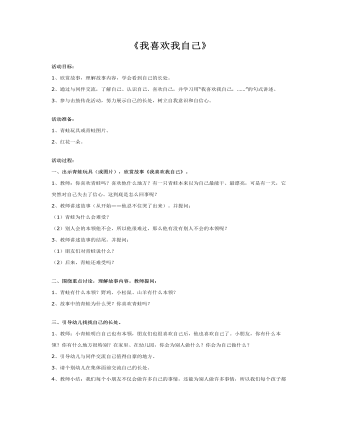
幼儿园大班社会活动教案:喜欢我自己
活动准备: 1、青蛙玩具或青蛙图片。 2、红花一朵。 活动过程: 一、出示青蛙玩具(或图片),欣赏故事《我喜欢我自己》。 1、教师:你喜欢青蛙吗?喜欢他什么地方?有一只青蛙本来以为自己最能干、最漂亮,可是有一天,它突然对自己失去了信心。这到底是怎么回事呢? 2、教师讲述故事(从开始——他忍不住哭了出来)。并提问: (1)青蛙为什么会难受? (2)别人会的本领他不会,所以他很难过,那么他有没有别人不会的本领呢? 3、教师讲述故事的结尾。并提问: (1)朋友们对青蛙说什么? (2)后来,青蛙还难受吗?

大班社会教案:我和爷爷奶奶同过节(重阳)
二、活动目的: 1、培养幼儿关心老人的情感。 2、体验与老人同过节的快乐。 1、增进艺术表现能力,学习运用学过的技能,合理地安排画面,画出爷爷奶奶的形象。 三、活动准备: 1、请爷爷奶奶来园参加活动。 2、幼儿自备自己制作的小礼物。 3、幼儿事先排练表演的节目。 4、纸笔幼儿人手各一份。
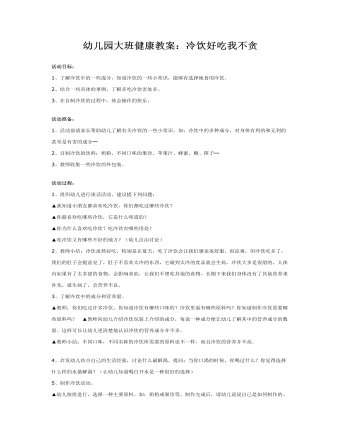
幼儿园大班健康教案:冷饮好吃我不贪
活动准备:1、活动前请家长帮助幼儿了解有关冷饮的一些小常识。如:冷饮中的多种成分,对身体有利的和无利的甚至是有害的成分┉2、自制冷饮的饮料:奶粉、不同口味的果珍、苹果汁、蜂蜜、糖、筷子┉3、教师收集一些冷饮的外包装。 活动过程: 1、组织幼儿进行谈话活动。建议提下列问题: ▲我知道小朋友都喜欢吃冷饮,你们都吃过哪些冷饮? ▲你最喜欢吃哪些冷饮,它是什么味道的? ▲你为什么喜欢吃冷饮?吃冷饮有哪些用处? ▲吃冷饮又有哪些不好的地方?(幼儿自由讨论)

幼儿园大班社会教案:假如我是爸爸妈妈
活动准备: 1、每人准备一张全家照。 2、幼儿向父母了解工作。 活动过程:一、幼儿介绍自己的父母。 1、提问:每个小朋友都有一个幸福的家,请你向大家介绍你的爸爸或者妈妈的姓名和他的工作,幼儿拿着照片介绍。 2、谈谈父母在家中做些什么事? 二、引导幼儿谈谈自己在家庭生活中的体验感受。 1、你喜欢自己的家吗? 2、在家里,你喜欢自己的爸爸妈妈吗?为什么?
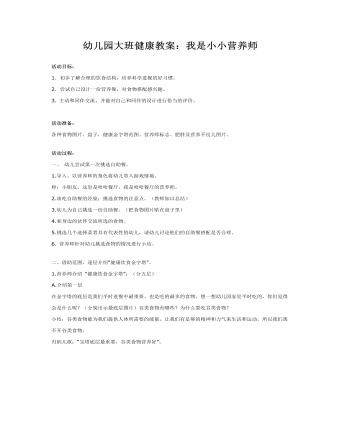
幼儿园大班健康教案:我是小小营养师
活动准备: 各种食物图片、盘子,健康金字塔范图、营养师标志、肥胖及营养不良儿图片。 活动过程: 一、幼儿尝试第一次挑选自助餐。 1.导入。以营养师的角色将幼儿带入游戏情境。 师:小朋友,这里是哈哈餐厅,我是哈哈餐厅的营养师。 2.谈吃自助餐的经验:挑选食物的注意点。(教师加以总结) 3.幼儿为自己挑选一份自助餐。(把食物图片贴在盘子里) 4.和身边的伙伴交流所选的食物。 5.挑选几个选择菜肴具有代表性的幼儿,请幼儿讨论他们的自助餐搭配是否合理。 6. 营养师针对幼儿挑选食物的情况进行小结。

大班健康:我们爱吃黑色食品教案
活动设计:一、游戏:瞎子品食 请幼儿闭上眼睛,品尝各种黑色食品,了解它们的好味道,排除对黑色食品的排斥心理。二、了解黑色食品 1、认识几种常见的黑色食品2、观看录像片段,了解黑色食品的营养价值及功用。
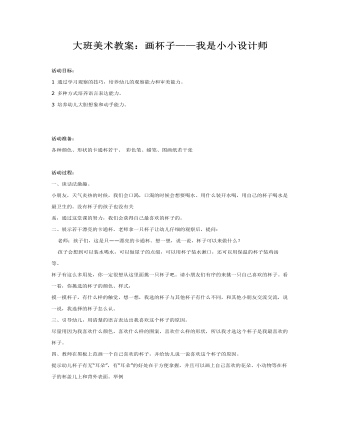
大班美术教案:画杯子——我是小小设计师
活动准备:各种颜色、形状的卡通杯若干、彩色笔、蜡笔、图画纸若干张 活动过程:一、谈话法激趣。小朋友,天气炎热的时候,我们会口渴,口渴的时候会想要喝水。用什么装开水喝,用自己的杯子喝水是最卫生的。没有杯子的孩子也没有关系,通过这堂课的努力,我们会获得自己最喜欢的杯子的。二、展示若干漂亮的卡通杯。老师拿一只杯子让幼儿仔细的观察后,提问: 老师:孩子们,这是只——漂亮的卡通杯。想一想,说一说,杯子可以来做什么? 孩子会想到可以装水喝水,可以做屋子的点缀,可以用杯子装水漱口,还可以用保温的杯子装鸡汤等。杯子有这么多用处,你一定很想从这里面挑一只杯子吧。请小朋友们有序的来挑一只自己喜欢的杯子。看一看,你挑选的杯子的颜色、样式,摸一摸杯子,有什么样的触觉,想一想,我选的杯子与其他杯子有什么不同,和其他小朋友交流交流,说一说,我选择的杯子怎么认。
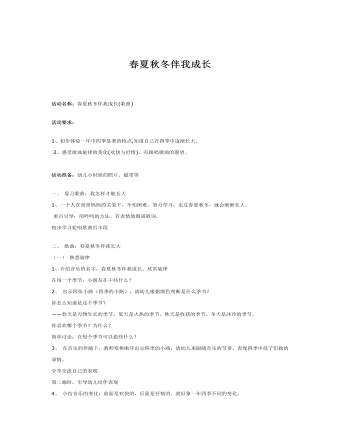
大班音乐教案:歌曲:春夏秋冬伴我成长
2、感受歌曲旋律的变化(欢快与抒情),有跟唱歌曲的愿望。 活动准备:幼儿小时候的照片、磁带等一、复习歌曲:我怎样才能长大1、一个人在爸爸妈妈的关爱下,不怕困难,努力学习,走过春夏秋冬,就会渐渐长大。 重点引导:用哼鸣的方法、有表情地朗诵歌词。初步学习轮唱歌曲后半段二、歌曲:春夏秋冬伴我长大(一)熟悉旋律1、介绍音乐的名字,春夏秋冬伴我成长。欣赏旋律在每一个季节,小朋友在干些什么?

